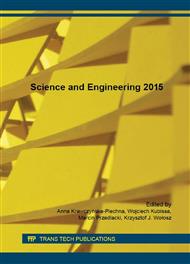[1]
K. Urbaniec, J. Wernik, K.J. Wołosz, Optimal design of the head of a pneumatic pulsator. Chem. Eng. Trans., Vol. 18 (2009), pp.237-242, DOI: 10. 3303/CET0918037.
Google Scholar
[2]
J. Wernik and K.J. Wołosz, Pneumatic pulsator design as an example of numerical simulations in engineering applications. Open Engineering, Vol. 2 (2012), pp.76-82, DOI: 10. 2478/s13531-011- 0050-5.
DOI: 10.2478/s13531-011-0050-5
Google Scholar
[3]
K. Wołosz and J. Wernik, Heat generation calculation on the basis of numerical simulation results of supersonic airflow in a nozzle. Chem. Eng. Trans., Vol. 39 (2014), pp.1363-1368, DOI: 10. 3303/CET1439228.
Google Scholar
[4]
J.C. Dutton, R.E. Coverdill, Experiments to Study the Gaseous Discharge and Filling of Vessels. Int. J. Eng. Ed. 2 (1997), 123-134.
Google Scholar
[5]
OpenFOAM® - The Open Source CFD Toolbox, www. openfoam. com, accessed: 2013-03-04.
Google Scholar
[6]
H. Honma, M. Ishihara, T. Yoshimura, K. Maeno and T. Morioka, Interferometric CT measurement of three-dimensional flow phenomena on shock waves and vortices discharged from open ends. Shock Waves, Vol. 13 (2003).
DOI: 10.1007/s00193-003-0206-1
Google Scholar
[7]
M. Le, I. Hassan, N. Esmail, The effects of outlet boundary conditions on simulating supersonic microchannel flows using DSMC. Appl. Therm. Eng. 27 (2007), 21-30. doi: 10. 1016/j. applthermaleng. 2006. 05. 013.
DOI: 10.1016/j.applthermaleng.2006.05.013
Google Scholar
[8]
G. Lodato, P. Domingo, L. Vervisch, Three-dimensional boundary conditions for direct and large-eddy simulation of compressible viscous flows. J. Comput. Phys. 227(2008), 5105-5143. doi: 10. 1016/j. jcp. 2008. 01. 038.
DOI: 10.1016/j.jcp.2008.01.038
Google Scholar
[9]
S.V. Utyuzhnikov, Robin-type wall functions and their numerical implementation. Appl. Numer. Math. 58 (2008), 1521-1533. doi: 10. 1016/j. apnum. 2007. 09. 003.
DOI: 10.1016/j.apnum.2007.09.003
Google Scholar
[10]
P. Moin, K. Mahesh, Direct Numerical Simulation: A Tool in Turbulence Research. Annu. Rev. Fluid Mech. 30 (1998), 539-578. doi: 10. 1146/annurev. fluid. 30. 1. 539.
DOI: 10.1146/annurev.fluid.30.1.539
Google Scholar
[11]
R. Moser, J. Kim, N. Mansour, Direct numerical simulation of turbulent channel flow up to Re= 590. Phys. Fluids 11 (1999).
DOI: 10.1063/1.869966
Google Scholar
[12]
C. Pozrikidis, Fluid Dynamics: Theory, Computation, and Numerical Simulation. Springer US, Boston, MA, (2009).
Google Scholar
[13]
F.R. Menter, Two-equation eddy-viscosity turbulence models for engineering applications. AIAA J. 32 (1994), 1598-1605. doi: 10. 2514/3. 12149.
DOI: 10.2514/3.12149
Google Scholar
[14]
T. Petrila, D. Trif, Basics of fluid mechanics and introduction to computational fluid dynamics. Springer US, Boston, MA, (2005).
Google Scholar
[15]
J. Tu, G.H. Yeoh, C. Liu, Computational Fluid Dynamics. A practical Approach. Elsevier, Amsterdam, (2008).
Google Scholar


